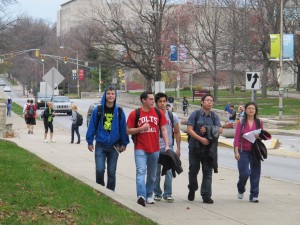Where College Graduates Are Going (Hint: Where Other College Grads Already Live)

Kyle Stokes / StateImpact Indiana
A new Brookings Institute report says some of the country's largest cities are seeing disproportionate growth in the number of residents with college degrees.
About 30 percent of Indianapolis residents have college degrees, putting it in the middle of the pack for educational attainment among the country’s 100 largest metropolitan areas. A Brookings Institution report shows that these areas have become less analogous over the last 40 years.
It used to be that the biggest cities had a similar percentage of residents with post-secondary education — about 12 percent, give or take a few points. But that’s changed since 1970. At the top of the 2010 list is Washington, D.C., where 46.8 percent of residents have a college degree. In comparison, just 15 percent of Bakersfield, Calif., residents can say the same thing. The Indianapolis-Carmel metropolitan area ranks 39th.
–Michael Bloomberg, New York Mayor
As more Americans go to college, the spread of educational attainment is growing in big cities. Now researchers are wondering if there’s something, some centrifugal force, that’s drawing college graduates away from some cities in favor of others. The New York Times visited Dayton, Ohio, which has lost about 1 percent of its college-educated young adults in the last decade even as that group grew 13 percent nationally. One recent graduate told the NY Times she was leaving Dayton — No. 85 on the Brookings list — for a teaching job in Charlotte, N.C., No. 28.
Unsurprising, writes Alan Berube on Brookings’ Up Front blog.
“A mixture of powerful economic phenomena are boosting the value of living around other college graduates,” says Berube. “Young educated workers will change jobs numerous times over their careers, which makes living in a large, ‘thick’ labor market with diverse opportunities more appealing.”
Currently, about one in three graduates of Indiana’s public universities leave for opportunities elsewhere. We’ve reported that the loss is most significant in small, rural communities where less than a quarter of educated residents might remain, according to a report released by Indiana University and the Indiana Workforce Intelligence System. Indianapolis’ position on the Brookings list indicates it’s at least staying competitive relative to other cities its size.
Berube says that areas like Dayton — whose significant manufacturing base has declined in recent decades — will need to reinvent themselves to appeal to keep recent college graduates:
This doesn’t mean, however, that it’s the end of the line for Dayton and other metro areas that are lagging in the race for highly educated workers. If nothing else, the experience of places like Pittsburgh indicates that progress is possible, even for metro areas that are not exactly migration magnets for young adults. But those places also provide a reminder that an upgrade in educational attainment doesn’t occur simultaneously, and often accompanies broader economic transition in the region.
What can Indiana do to increase its appeal to young, college-educated adults?